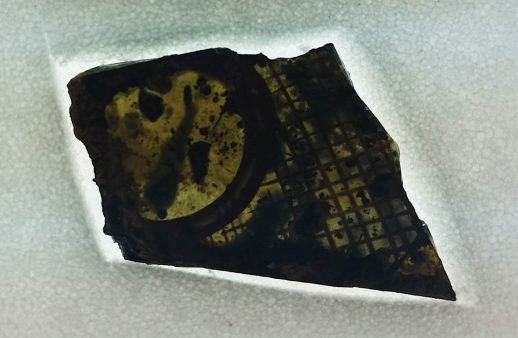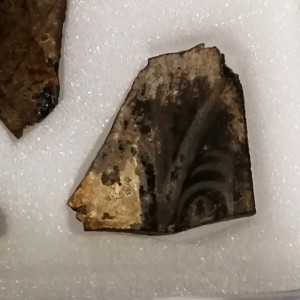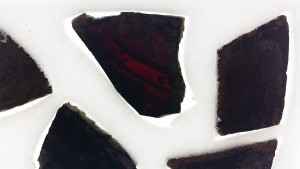Looking Through the Window Glass
8 December 2016
Over the past year, there has been a lot of activity centered around the treatment procedure of the Blackfriary medieval window glass. To an outsider, it would look like nothing was happening for the first six months. However, the initial stage of the treatment was centered on understanding the glass structure and researching possible treatment strategies. Since this glass was in a damp environment for most, if not all, of its time in the ground, the largest challenge was figuring out how to remove the water from inside the glass without it crumbling away.
It was decided that transitioning the glass slowly from a solution made primarily of water to one made purely of solvent, and finally to one of a consolidant (Paraloid B-72: an ethyl methacrylate and methyl acrylate co-polymer) would remove all the water and replace it with a sturdy material that would support the glass matrix and make it strong enough for research and handling. After testing this procedure, the next task was to assemble a team to help me tackle the immense task of treating all of the nearly two hundred boxes of glass. Luckily, almost everyone in the lab this year was enthusiastic about helping and we are now rotating on a schedule of two conservators per week per twenty boxes of glass. So far we have treated around eighty boxes of glass with tremendous success, and only a few growing pains! While most of the glass has darkened or has insoluble surface concretions, we have seen some beautiful colors and designs.
As we move into the next part of the school year, we will continue to treat the remaining glass and begin to look into the analysis of it. We hope to be able to characterize the glass and pigments based on their chemical composition using equipment such as an x-ray fluorescence spectrometer (XRF) and a scanning electron microscope (SEM). Be sure to come back in the spring to see what we uncover!
All photographs show glass fragments after treatment in their custom-cut foam supports, ready to go into boxes for storage. Photos taken by Chloe Pearce.
Check out my first blog post to see where this project began.
For more information on the process before the glass arrived at our lab click here.
Comments
3 comments
Comments are closed.
- March 2024 (1)
- December 2023 (1)
- November 2023 (2)
- March 2023 (2)
- January 2023 (6)
- November 2022 (1)
- October 2022 (1)
- June 2022 (6)
- January 2022 (8)
- March 2021 (2)
- January 2021 (3)
- June 2020 (1)
- May 2020 (1)
- April 2020 (1)
- March 2020 (4)
- February 2020 (3)
- January 2020 (5)
- November 2019 (1)
- October 2019 (1)
- June 2019 (1)
- April 2019 (2)
- March 2019 (1)
- January 2019 (1)
- August 2018 (2)
- July 2018 (5)
- June 2018 (2)
- May 2018 (3)
- March 2018 (1)
- February 2018 (3)
- January 2018 (1)
- December 2017 (1)
- October 2017 (4)
- September 2017 (1)
- August 2017 (2)
- July 2017 (1)
- June 2017 (3)
- May 2017 (1)
- March 2017 (2)
- February 2017 (1)
- January 2017 (5)
- December 2016 (2)
- November 2016 (2)
- June 2016 (1)
- March 2016 (1)
- December 2015 (1)
- July 2014 (1)
- February 2014 (1)
- January 2014 (4)


Great work guys – from all at the Black Friary!!
So glad to see that the glass is responding so well, and that there are some lovely designs. Well done, and Black Friary thanks you!.